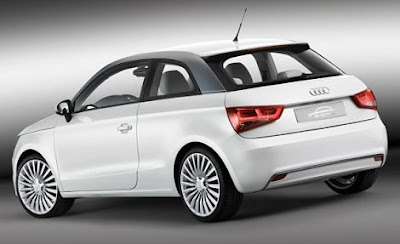Audi A1 e-tron Reviews

The synchronous electric motor of the Audi A1 e-tron is mounted transversely at the front of the car. The electric motor sends its power to the front wheels via a single-speed transmission. The power electronics are mounted in the engine compartment above the electric motor. The Audi A1 e-tron can drive 31 miles emission-free in city traffic on the powerful battery. The range extender
The A1 e-tron concept car has a Wankel engine as a range extender, but other compact concepts are also possible. The fuel tank holds 12 liters.
The innovative Mega City Vehicle, which despite its complex drive technology weighs only 1,190 kilograms delivers zero-emission driving fun in a modern and sophisticated manner. The Audi A1 e-tron can also cover longer distances if the range extender charges the battery. In electric mode, there are zero local CO2 emissions – the compact A1 e-tron is thus ecological and economical.
Audi has us driving what it calls a prototype of its A1 e-tron. It drives like it, too.
The A1 e-tron is a series hybrid and a plug-in hybrid, too. It all means that, while it has a small petrol motor onboard, it only ever runs as an electric car.
In fact, the e-tron can stretch to 50km of pure electric running on one charge of its lithium-ion battery pack. Let the quiet little rotary running to help the electrics and it will stretch the range out to 250km -- though the petrol engine has no connection whatsoever to the wheels or the transmission, and so it never does more than charge up the batteries.
It's just a pure electric car, albeit a smooth, organised, beautifully built electric car. With its electric motor up the front, its battery pack mostly under the back seat, the rotary engine sits beneath the cargo area.
Even if the Sanyo-sourced lithium-ion batteries are expensive and the AVL-built rotary is a hand-built test motor, the thing just feels, well, right.
It's a beautifully refined car at low speeds. The electric motor is good for 75kW and 240Nm but only for fleeting bursts. Its normal output (or continuous output, in the burgeoning electric car language) is 45kW and 150Nm.
Audi claims it picks up about a third of its urban requirements by briefly turning the electric motor into a generator to recover energy every time the car coasts or brakes to a halt.
"Think of the rotary as a spare can of petrol for the electric motor and you'll be on the right track," A1 e-tron project leader, Dietrich Englehart, suggested.
"Megacity customers will run 90 per cent of the time with just the electric motor, so the rotary's consumption is not a big issue. So rarely does the rotary engine run, Audi claims a combined fuel economy figure of 1.9L/100km and a CO2 figure of 42 grams/km.
The other key point is that the battery will charge in three hours on a household socket, so most house-office-house journeys won't even start the rotary engine, which Audi prefers to call the Range Extender.
Audi suggests you might have to fill the 12-litre fuel tank once a year -- if you're unlucky.
It is powered primarily by an electric motor driving the front wheels, powered by a small battery pack. However, when the battery is exhausted, a tiny Wankel engine (mounted under the boot floor) kicks in and drives a generator, which, in turn, powers the electric motor. Like nearly all electric cars, the A1 has a single speed transmission.
In place of the usual ICE transmission, the A1 e-tron's nose not only gets the electric motor, but also houses a DC/DC inverter, the motor’s electronic control system, a battery charger, a standard 12v battery and a high voltage air conditioning compressor.
Situated in the rear half of the transmission tunnel and under the rear seats is the car’s Sanyo Lithium-Ion battery pack. What makes the A1 e-tron really special is the 'Range Extender generator module'. This is based around a tiny, 245cc, single rotar, Wankel engine. It generates a maximum 20bhp, driving a generator, which provides electricity once the battery has been run down to its lowest charge.
The Chevy Volt was trailed by GM as being a range extender but, in certain high-speed situations, the Volt's engine can be coupled directly to the car’s electric motor. Genuinely exceptional. Despite the extra weight of the range extender running gear, the A1 had enough verve to be interesting.
Not all Range Extender systems will be this well integrated or refined, but this system has to be the way forward for production electric vehicles.
